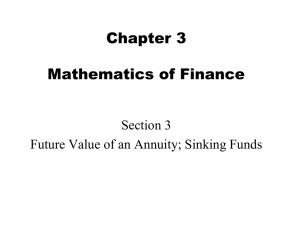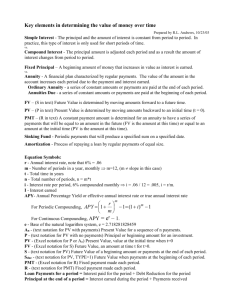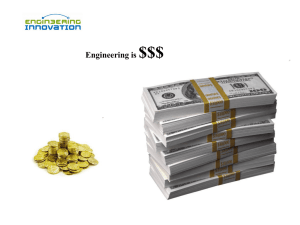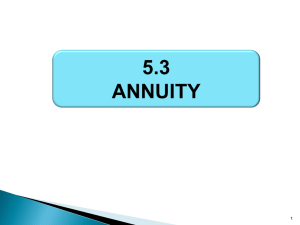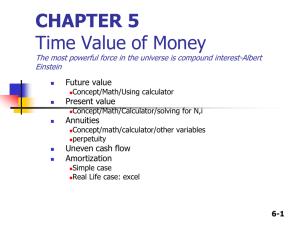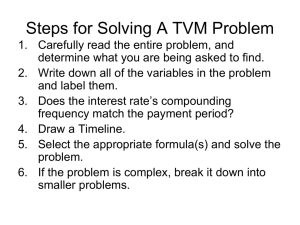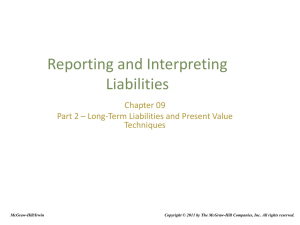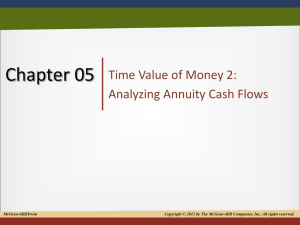Time Value of Money
advertisement
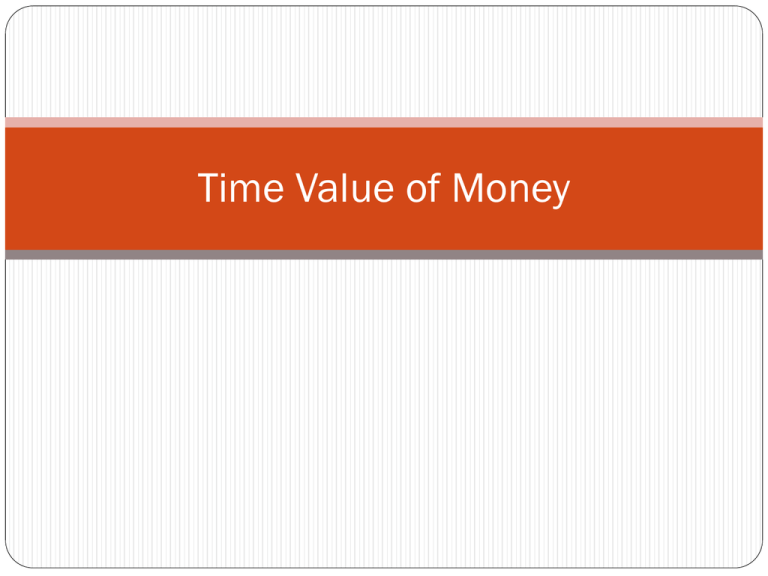
Time Value of Money Objectives Calculate the future value of a dollar amount that you save today Calculate the present value of a dollar amount that will be received in the future Calculate the future value of an annuity Calculate the present value of an annuity TVM importance Opportunity cost causes money to change value as it moves over time. Can be applied to a single dollar amount—also called a lump sum Can also be applied to an annuity Annuity: a series of equal cash flow payments that occur at the end of each period An example would be a monthly deposit of $50 into your savings account Time Lines – Picture Time Future Value of a Single Dollar Amount Compounding – process by which money accumulates interest. Future Value Amount of money deposited Interest rate per period Number of periods the money will grow Picture Time Future Value of a lump sum Nominal vs. Periodic Nominal Rate – Stated Annual Rate Periodic Rate – rate per period Example: Nominal = 10% Monthly Periodic Rate = ? Future Value Interest Factor FVIF - what is this? How to calculate Table Value Formula Business Calculator Example: Suppose you want to know how much money you will have in five years if you invest $5,000 now and earn an annual return of 9 percent The present value of money (PV) is the amount invested, or $5,000 Find the interest rate of 9 percent and a time period of five years on the table Answer: Suppose you want to know how much money you will have in five years if you invest $5,000 now and earn an annual return of 9 percent $5,000 x ___________ = _______________ Or by formula: Another Problem 1 If you deposit $1,000 at a nominal rate of 10%, compounded annually for one year, how much will you have at the end of the year? If it is compounded monthly? Table Factor: Formula: Answers: $1,100.00; $1,104.71 Another Problem 2 If you deposit $1,000 at a nominal rate of 10%, compounded annually for three years, how much will you have at the end of the year? If it is compounded monthly? Answers: $1,331.00; $1,348.18 Present Value Discounting – the process of obtaining present values. Need: $ amount to be received in the future Periodic rate to be earned on the money Number of periods invested Picture Time Present Value of a lump sum Present Value Interest Factor PVIF - what is this? How to calculate Table Value Formula Business Calculator Example Present Value You would like to accumulate $50,000 in five years by making a single investment today.You believe you can achieve a return from your investment of 8 percent annually. What is the dollar amount that you need to invest today to achieve your goal? continued You would like to accumulate $50,000 in five years by making a single investment today.You believe you can achieve a return from your investment of 8 percent annually. What is the dollar amount that you need to invest today to achieve your goal? 50,000 x _________ = ________________ Formula: Answer: $34,029.15 Example 2 You would like to accumulate $50,000 in five years by making a single investment today.You believe you can achieve a return from your investment of 8 percent annually, but compounded monthly. What is the dollar amount that you need to invest today to achieve your goal? Answer: 33,560.52 Example 3 How much would you pay for an investment that is going to earn you 6% over 3 years (annually) and at the end of the 3 years you will receive $17,000? Present value of 17,000 at 6% for 3 years = Table: Formula: Answer: $14,273.53 Annuities – Picture Time Stream of equal amounts paid or received Ordinary Annuity – Annuity Due - Perpetuity - Future Value of an Annuity (FVA) How to read the table I = periodic interest rate N = number of payments (payment frequency MUST match the interest rate for that period) Answers: How much money will I have if I deposit $X each period for N periods at I rate per period? (end of period payments) Example 1 - FVA Suppose that you have won the lottery and will receive $150,000 at the end of every year for the next 20 years. As soon as you receive the payments, you will invest them at your bank at an interest rate of 7 percent annually. How much will be in your account at the end of 20 years, assuming you do not make any withdrawals? Continued Suppose that you have won the lottery and will receive $150,000 at the end of every year for the next 20 years. As soon as you receive the payments, you will invest them at your bank at an interest rate of 7 percent annually. How much will be in your account at the end of 20 years, assuming you do not make any withdrawals? Picture: Table: $150,000 x __________ = _____________ Calculator: Answer: $6,149,323.85 Example 2 You need to have $1,000,000 in 30 years when you retire. How much will you have to deposit at the end of each year if the deposit earns 5% to have the $1,000,000? FVA = PMT x FVAF; PMT = FV/FVAF 1,000,000 / 66.4388 = 15,051.45 (table) Calculator: $15,051.44 Present Value of an Annuity (PVA) Discounting the individual cash flows of the annuity and adding them up. Factor x annuity = PVA I = periodic interest rate N = number of periods in the annuity Rate per period must match the annuity frequency Picture Time- PVA Time Line Example 1 Suppose you have just won the lottery. As a result of your luck, you will receive $82,000 at the end of every year for the next 25 years. Now, a financial firm offers you a lump sum of $700,000 in return for these payments. If you can invest your money at an annual interest rate of 9 percent, should you accept the offer? Continued Suppose you have just won the lottery. As a result of your luck, you will receive $82,000 at the end of every year for the next 25 years. Now, a financial firm offers you a lump sum of $700,000 in return for these payments. If you can invest your money at an annual interest rate of 9 percent, should you accept the offer? Present value of the Annuity = ? 82,000 x ________ = ______________ Should you accept or reject the offer? Answer: $805,486 Example 2 You want to buy a house. Based on your cash flows you figure that you can afford $750 each month on the mortgage payment (not including taxes and insurance escrow). Mortgage rates are 12% nominal (1% per month). How much house can you afford to buy if you want to pay for it over 50 months. (50/12 = 4 years + 2 months). PVA = PVAF x PMT PVA = 39.1961 x $750 = 29,397.07 Example 3 You want to buy a car over 5 years. The cost is 25,000. What will be your annual payment be if the interest rate is 10%? Annual PMT = PVA/PVAF = 25,000/3.7908 = 6,594.91 Monthly I = 10/12; 5 x 12 periods = 60; PVIF = 47.06537 (by calculator) PMT = $531.18 Amortization – the annual car loan Year 1 2 3 4 5 Beg. Bal. 25,000.00 20,905.06 16,400.63 11,445.76 5,995.40 Payment 6,594.94 6,594.94 6,594.94 6,594.94 6,594.94 Interest 2,500.00 2,090.51 1,640.06 1,144.58 599.54 Prin. Pay 4,094.94 4,504.43 4,954.87 5,450.36 5,995.40 End Bal. 20,905.06 16,400.63 11,445.76 5,995.40 0.00 pmt = 6,594.937 n=5 I = .10 The ending balance is also the present value of the remaining payments. Perpetuity – Example An investment promises you a payment of $724.00 at the end of each year forever. How much would you pay for this investment if your opportunity cost is 6.4%? PV = PMT / Rate = 724.00/0.064 = $11,312.50 So: $11,312.50 x 0.064 = 724.00 Annuity Due - Example You need to save $50,000 to help put your child through college in 10 years. You want to make 10 payments starting now to have the 50,000 in 10 full years. How much do you have to deposit at the beginning of each year if you can earn 5% on the money? Table answer: PMT = FV / FVAF (1+i) 50,000 / [FVAF x (1+i)] = 50,000 /12.5779 (1.05) = 50,000 / 13.206795 = 3,785.93 Effective Rate – Simple example APR = Annual Percentage Rate: Required in Federal Legislation for disclosure. (Rate/per) x periods adjusted for costs. Effective Rate = the actual rate considering compounding. Suppose you borrow 12,000 to buy a car at a nominal rate of 8.5% paid annually vs. another bank 8.3% paid monthly. Which loan has the lowest effective rate? No loan costs. Effective Rate Annual = 8.5%, APR = 8.5% Effective rate Monthly = ([1+ .083/12]^12) – 1 = 1.08623 – 1 = 8.623% APR = 8.3% Effective Rate – Excel Spreadsheet Motrgage Example Change this: Nominal Rate Years Per per year Amt. Borrowed Costs 0.07 30 12 100,000 2000 Nominal Rate Periodic Rate Yrs x per/yr Payment Used Funds Payment Effective Periodic APR Effective Annual 0.0700000 0.0058333 360 $665.30 98,000.00 $665.30 0.006001131 0.072013573 0.074438664


